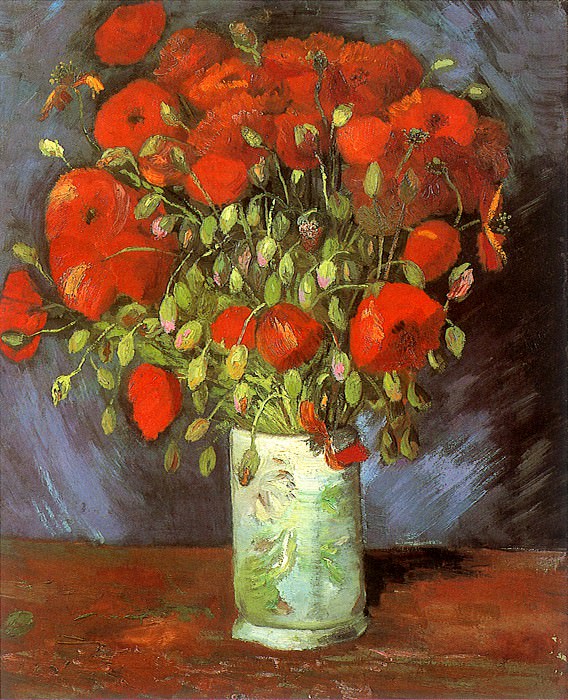Vase with Red Poppies Vincent van Gogh (1853-1890)
Vincent van Gogh – Vase with Red Poppies
Edit attribution
Download full size: 2488×3071 px (1,4 Mb)
Painter: Vincent van Gogh
Location: Wadsworth Athenaeum, Hartford.
The painting "Vase with Red Poppies" was painted by Van Gogh in the summer of 1886 after he moved to Paris. The Paris period was very fruitful for him, during these years the artist painted about 250 paintings. "Vase with Red Poppies" is one of a whole series of still lifes from Van Gogh’s Parisian period. The Impressionist technique fascinated the artist and gradually the palette of melancholy beauties was replaced by red, orange, green, blue and, of course, yellow colors. Still Life Vase with Red Poppies is one of Van Gogh’s first works from his Parisian period. It depicts a bouquet of large red poppies in a white vase.
Description of Vincent Willem van Gogh’s painting "Vase with Red Poppies"
The painting "Vase with Red Poppies" was painted by Van Gogh in the summer of 1886 after he moved to Paris.
The Paris period was very fruitful for him, during these years the artist painted about 250 paintings. "Vase with Red Poppies" is one of a whole series of still lifes from Van Gogh’s Parisian period.
The Impressionist technique fascinated the artist and gradually the palette of melancholy beauties was replaced by red, orange, green, blue and, of course, yellow colors.
Still Life Vase with Red Poppies is one of Van Gogh’s first works from his Parisian period.
It depicts a bouquet of large red poppies in a white vase. By the brightness, saturation and purity of the red color that the artist used for poppies, it is noticeable that he had already begun to master the new trends in art for him. But the predominance of dark colors in the background and purple and brown tablecloth, on which stands a vase and a few fallen leaves, show the commitment of Van Gogh to the usual techniques for him.
The artist wants to highlight the brightness of the bouquet so much that he simply fills the petals with scarlet paint.
Poppies seem to cover the entire space of the picture. Due to the diagonal and circular sweeping strokes that the artist paints the picture with, the bouquet becomes three-dimensional and seems to stretch towards the drawn gaze of the viewer.
The whiteness of the vase emphasizes the tenderness of the light green, not yet blooming, buds.
Unusual for Van Gogh, the color scheme emphasizes the bright contrasting combination of saturated pure colors.
The harmony of the color scheme characterizes the painting as an optimistic and cheerful work.
Van Gogh’s Still Life Vase of Red Poppies is currently in the Wadsworth Athenaeum Museum of Art in Hartford, Connecticut, USA.
Кому понравилось
Пожалуйста, подождите
На эту операцию может потребоваться несколько секунд.
Информация появится в новом окне,
если открытие новых окон не запрещено в настройках вашего браузера.
You need to login
Для работы с коллекциями – пожалуйста, войдите в аккаунт (open in new window).




















You cannot comment Why?
The subtexts in this painting can be interpreted in several ways. Poppies themselves are often associated with remembrance, particularly in the context of war and fallen soldiers, due to their connection to the battlefields of World War I. They can also symbolize sleep, peace, and even oblivion. The vibrant intensity of the red could suggest passion, life, and vitality, but in contrast to the ephemeral nature of the poppy, it might also hint at the fleetingness of these qualities. The slight wilting or drooping of some of the poppies and the presence of buds alongside fully opened flowers can represent the cycle of life, growth, and decay. The bold and energetic brushwork might suggest the artists emotional state – perhaps a sense of urgency, joy, or even underlying turmoil. The rich, dark background can create a sense of intimacy and focus, drawing the viewers attention to the stark beauty and symbolic weight of the poppies. Therefore, the painting can be seen as a meditation on life, beauty, fragility, memory, and the intensity of human experience.